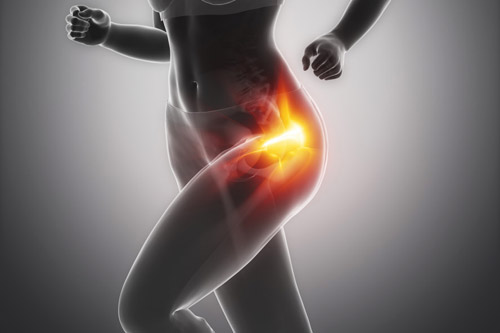Trochanteric bursitis is a condition that results in pain and inflammation in the hip. The trochanteric bursa is a small sac of fluid located on the outside of the hip that helps to cushion and lubricate the joint. When this bursa becomes inflamed, it can cause significant pain and discomfort. There are a number of ways that you can treat trochanteric bursitis, depending on the severity of your symptoms. In this blog post, we will discuss the various treatment options available for this condition.
Contents
What Is Trochanteric Bursitis?
 The trochanteric bursa is a small, fluid-filled sac located near the hip joint. It helps to cushion and protect the hip joint from impact. Trochanteric bursitis is a condition in which this bursa becomes inflamed. In simple words, trochanteric bursitis is the inflammation of the trochanteric bursa.
The trochanteric bursa is a small, fluid-filled sac located near the hip joint. It helps to cushion and protect the hip joint from impact. Trochanteric bursitis is a condition in which this bursa becomes inflamed. In simple words, trochanteric bursitis is the inflammation of the trochanteric bursa.
It is a common condition that can cause pain and swell outside your hip. The condition is also known as greater trochanteric pain syndrome (GTPS). GTPS is a condition that affects the bursa, which is a small, jelly-like sac that acts as a cushion between bones and tendons. The bursa helps to reduce friction between these structures.
Trochanteric bursitis can occur when the bursa becomes irritated or inflamed. This can happen due to overuse or injury of the hip joint. The condition is more common in women and people over the age of 40. Or this can also be a result of certain medical conditions, such as rheumatoid arthritis or gout.
Therefore if you feel like you’re developing trochanteric bursitis, it’s best to seek medical attention as soon as possible. An early diagnosis and treatment can help prevent the condition from worsening and causing more pain.
How Does It Feel Like?
It is not easy to identify the condition as this only happens when the bursa is irritated or inflamed. When this occurs, you will feel a deep ache in the hip that gets worse when you move around, lie on that side, put pressure on the hip (for instance, when sitting for long periods), or climb stairs.
The pain may also travel down to your thigh. You may feel a dull throbbing sensation or sharp pain when you touch the affected area. There may also be swelling and warmth around the hip.
In addition, there may be some loss of range of motion in the hip. For instance, you may find it hard to rotate your leg outwards or lie on your side. A few common signs might include:
- Pain when lying on the affected side
- Pain when pressure is applied on the hip (for instance, when sitting)
- Sharp pain or dull ache with movement
- Difficulty moving the leg outwards or lying on the affected side
- Swelling and warmth around the hip
So if you are experiencing any of these symptoms, it is important to see a doctor so that they can rule out other possible causes of your hip pain (such as arthritis) and provide you with the appropriate treatment.
How Is It Diagnosed?
 The diagnosis of trochanteric bursitis is made based on a person’s symptoms and a physical examination. An x-ray may be ordered to rule out other causes of pain, such as arthritis or a fracture. It is important to note that x-rays cannot definitively diagnose bursitis, but can be helpful in excluding other causes.
The diagnosis of trochanteric bursitis is made based on a person’s symptoms and a physical examination. An x-ray may be ordered to rule out other causes of pain, such as arthritis or a fracture. It is important to note that x-rays cannot definitively diagnose bursitis, but can be helpful in excluding other causes.
If the diagnosis is unclear, or if bursitis does not respond to initial treatment, your doctor may recommend an MRI or CT scan to further evaluate the condition.
These tests will help to determine the severity of bursitis and whether there is any associated damage to the hip joint or surrounding structures. It is important to note that these tests are generally not necessary to diagnose bursitis and can often be avoided if the diagnosis is clear based on symptoms and physical examination.
Therefore, if you are diagnosed with trochanteric bursitis, treatment can begin without the need for further testing.
How To Treat Trochanteric Bursitis?
Now, the most important question is how to treat trochanteric bursitis. In most cases, this problem can be resolved without any surgery. However, in some severe conditions, the doctor may recommend surgery. Let’s discuss many of the possible treatments for this problem.
Non-surgical Treatment
The initial treatment is always non-surgical. The doctor will recommend some lifestyle changes and medications to ease the pain and inflammation. These include:
- Rest: It is important to rest the affected hip. This will help in reducing pain and inflammation. You can take complete bed rest or partial bed rest.
- Ice: Applying ice packs to the affected area will also help in reducing pain and inflammation. Do this for 15-20 minutes at a time, several times a day.
- Compression: Wearing compression garments will help in controlling the swelling.
- Elevation: Keeping the affected hip elevated will also reduce swelling.
- Medications: The doctor may also prescribe some pain-relieving and anti-inflammatory medicines. These include ibuprofen, naproxen, etc. In some cases, the doctor may also give injections of corticosteroids to reduce inflammation. Medications work well in reducing pain and inflammation. However, they do have some side effects.
Surgical Treatment
 In some severe cases, the doctor may recommend surgery. This is usually done when other treatments have failed to work. Surgery involves removing the damaged bursa or repairing it. The surgeon will also look for any other underlying problems that may be causing bursitis. Surgery is usually the last resort and is only done if the pain is severe and does not go away with other treatments.
In some severe cases, the doctor may recommend surgery. This is usually done when other treatments have failed to work. Surgery involves removing the damaged bursa or repairing it. The surgeon will also look for any other underlying problems that may be causing bursitis. Surgery is usually the last resort and is only done if the pain is severe and does not go away with other treatments.
The surgery can be done as an outpatient procedure, which means you will not have to stay in the hospital overnight. The surgeon will make small incisions in your skin and insert a camera into the incision. This is called arthroscopy. The surgeon will then look inside the joint and repair the damage.
After surgery, you will need to rest and avoid putting weight on the joint. You may need to use crutches for a few weeks. Physical therapy may also be recommended to help you recover.
Therefore, these are some treatment options that you can choose to treat your trochanteric bursitis. You should always consult with your doctor to see what is best for you. Because if the pain is severe, you may need to opt for surgery. But remember, you can recover from this and live a pain-free life.
How Does Physical Therapy Help In Trochanteric Bursitis?
There are many ways in which physical therapy can help treat trochanteric bursitis. Physical therapy helps by reducing the inflammation, pain, and stiffness associated with the condition. It also helps improve the range of motion and strengthens the muscles around the hip joint.
One of the most common treatments for trochanteric bursitis is ultrasonic therapy. Ultrasonic therapy uses sound waves to reduce inflammation and pain. It is a non-invasive and safe treatment option. For example, this therapy works by breaking down the inflammatory cells that are causing pain and swelling.
Other physical therapy treatments for trochanteric bursitis include:
- Ice – Ice can help reduce inflammation and pain. It is advisable to ice the affected area for 20-30 minutes several times a day.
- Heat – Heat helps improve blood circulation and reduces pain and stiffness. It is advisable to apply heat for 20-30 minutes several times a day.
- Massage – Massage helps improve blood circulation and reduce pain and inflammation.
- Exercise – Exercise helps strengthen the muscles around the hip joint and improve the range of motion. It is important to consult with a physical therapist before starting any exercise program.
- Stretching – Stretching helps improve the range of motion and flexibility. It is important to consult with a physical therapist before starting any stretching program.
These things are all important to think about when you are wondering how physical therapy can help in treating trochanteric bursitis. If you have any questions, be sure to ask your doctor or physical therapist. They will be able to help create a plan that is best for you. Also, do not forget to rest and ice the affected area. This will also help in reducing pain and inflammation.
Can It Be Prevented?
 Well, this is a tricky question. While some causes of trochanteric bursitides, such as overuse or injury, can be prevented, others, such as age-related degeneration, cannot. However, there are some things you can do to lower your risk of developing the condition, including:
Well, this is a tricky question. While some causes of trochanteric bursitides, such as overuse or injury, can be prevented, others, such as age-related degeneration, cannot. However, there are some things you can do to lower your risk of developing the condition, including:
- Wearing proper shoes that support your feet and ankles
- Stretching regularly
- Practicing good posture
- Using proper form when participating in activities or exercises
- Avoiding sudden movements or overuse of the affected area
These tips are often also recommended as treatments for those who already have the condition. In addition to these general measures, your doctor may also recommend specific treatments based on the underlying cause of your bursitis. Prevention can go a long way in protecting you from the pain of trochanteric bursitis, but if you do develop the condition, don’t despair.
With proper treatment, you can find relief and get back to your normal activities. It is important to follow your doctor’s recommendations and not try to treat the condition on your own, as this can make it worse. If you have any questions or concerns, be sure to ask your doctor.
Conclusion
In conclusion, trochanteric bursitis is a condition that can be very painful and debilitating. However, there are a number of treatment options available that can help to lessen the pain and improve function. If you think you may have this condition, it is important to see your doctor so that an accurate diagnosis can be made and the best possible treatment plan can be put in place.
Therefore, with the help of medical management and certain self-care measures, it is possible to get relief from the pain and discomfort associated with trochanteric bursitis.
Physical Therapy help patients recover from pain. If you’re experiencing Back pain, Shoulder pain, Knee pain, Neck pain, Elbow pain, Hip pain, or Arthritis pain, a physical therapist at MantraCare can help: Book a physiotherapy session.


